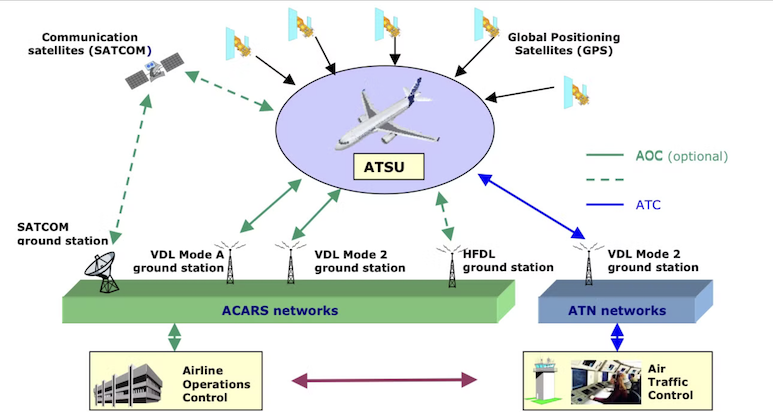Communication And Management Unit
The Communication and Management Unit (CMU) is a critical avionics component in modern aircraft — especially those equipped for data link communications like ACARS, CPDLC, or ATN. Here’s a clear explanation:
Definition
The Communication and Management Unit (CMU) is the central data link processor on an aircraft. It manages, routes, and controls digital messages between:
- the aircraft systems (e.g., Flight Management System, cockpit displays), and
- the external communication networks (like VHF, HF, or SATCOM).
It’s essentially the “brain” of the aircraft’s data communication system.
📡 Main Functions
Message Management
- Handles ACARS (Aircraft Communications Addressing and Reporting System) messages.
- Formats, encodes, and routes uplink (ground → aircraft) and downlink (aircraft → ground) messages.
- Ensures proper delivery and acknowledgment.
Network Management
- Chooses the most appropriate communication link (VHF, HF, SATCOM) depending on coverage and cost.
- Acts as a “router” for datalink — similar to how an internet router picks the best network path.
System Integration
Interfaces with avionics like:
- FMS (Flight Management System)
- MCDU (Multipurpose Control and Display Unit)
- ATC data link systems (for CPDLC, “Controller–Pilot Data Link Communications”)
- Aircraft Condition Monitoring Systems (ACMS)
Provides data for operational and maintenance reports.
Protocol Management
Supports various communication protocols:
- ARINC 618 (ACARS)
- ARINC 622 (ATN)
- ARINC 745/758 (CMU and MCDU interfaces)
Converts messages between these formats as needed.
⚙️ Typical Communication Path
Crew input → MCDU → CMU → Data link (VHF/HF/SATCOM) → Ground Station / Airline Ops Center / ATC
Example:
- Pilot sends a position report from the MCDU.
- The CMU formats and routes it via the best available network (e.g., VHF data link).
- The message reaches ATC or the airline’s operations center.
🛰️ CMU in Modern Aircraft
- Airbus: Uses an ATSU (Air Traffic Services Unit), which performs similar CMU functions.
- Boeing: Typically installs a CMU as a standalone unit.
- In newer architectures (like Boeing 787 or Airbus A350), the CMU functions may be integrated into other avionics such as the Core Network or Avionics Communication Router.
🧩 In Summary
| Function | Description |
|---|---|
| Core Role | Manages aircraft digital communications |
| Interfaces | FMS, MCDU, ATC, airline operations |
| Networks | VHF, HF, SATCOM |
| Standards | ARINC 618, 619, 620, 622 |
| Examples | Honeywell CMU-900, Collins CMU-4000 |

Here’s a conceptual block diagram of how a Communication & Management Unit (CMU) / ACARS system typically connects aircraft systems with ground stations and networks:
┌──────────┐
│ Pilot / │
│ Flight │
│ Deck │
└────┬─────┘
│
│ (input, display, commands)
▼
┌────────────────────┐
│ Communication & │
│ Management Unit │ ←── (Router / message manager)
│ (CMU) / ACARS MU │
└────┬──────┬─────────┘
│ │
┌───────────┘ └───────────┐
│ │
▼ ▼
Radio / Data Link Hardware Aircraft Systems / Sensors
(VHF, HF, SATCOM) (FMS, sensors, status, etc.)
│ ▲
│ │
└───────────┬─────────────────┘
│ (antenna, coupling)
▼
┌────────────┐
│ Ground / │
│ Satellite / │
│ Network / │
│ Service │
│ Provider │
└────────────┘
Explanation of major blocks
Pilot / Flight Deck The pilot or flight deck interface (MCDU, cockpit displays) is where messages are viewed, commands entered, etc. The CMU interacts with this interface.
CMU / ACARS Management Unit This is the “brain” that formats, routes, stores, and handles message logic: deciding which link to use, acknowledgments, retries, protocol handling, etc.
Data Link / Radio Hardware Physical transmitters/receivers for VHF data link, HF (high-frequency), or satellite (SATCOM) communications. The CMU sends data to these based on coverage and policy.
Aircraft Systems / Sensors The CMU gets inputs (e.g. sensor status, position, system health) from avionics subsystems (e.g. FMS, DFDR, etc.). It may also provide outputs or carry commands into those systems.
Ground / Network / Service Provider On the ground side, there is a network infrastructure (ground stations, satellite links, data centers, airline operations centers, ATC centers) that receives and routes messages between aircraft and operations/ATC systems.